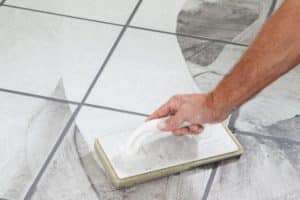Stained tiles ruining your home’s sparkle? You’re not alone. Many homeowners struggle with how to clean stained floor tiles, especially when regular mopping just doesn’t cut it. If you’ve been scrubbing endlessly with no results, this guide is for you.
We’ll walk you through proven techniques to restore your tiles to their original shine. Whether it’s grime in the kitchen or hard water marks in the bathroom, you’ll learn how to clean stained floor tiles using simple methods, many with ingredients you already have at home.
Understanding the Common Causes of Tile Stains
Before tackling stains, it helps to understand their root causes. Common tile stains come from:
- Hard water deposits
- Grease and food spills
- Soap scum or mildew in bathrooms
- Grout discoloration
- Rust from metal items
Identifying the source allows you to choose the right cleaning method and avoid damaging your tile surface.
Everyday Cleaning vs. Deep Cleaning

Regular sweeping and mopping help maintain cleanliness, but aren’t enough for deep stains.
- Everyday Cleaning: Keeps dirt and dust under control, but doesn’t tackle embedded stains.
- Deep Cleaning: Involves targeted stain removal using stronger solutions and more intensive scrubbing.
To restore stained tiles, you’ll need a deep-cleaning strategy based on the stain type and tile material.
Choosing the Right Method for Your Tile Type
Not all tiles are created equal. Understanding your tile material will help you choose safe and effective cleaning methods.
- Ceramic & Porcelain: Durable and compatible with vinegar, lemon juice, and most DIY cleaners.
- Natural Stone (e.g., marble, travertine, slate): Acid-sensitive. Avoid vinegar or lemon—use only pH-neutral products.
- Vinyl & Linoleum: Prone to scratching. Stick with mild detergents and avoid abrasive scrubbing.
When in doubt, test cleaners on a hidden corner first.
DIY Cleaning Methods Using Household Items
Here are easy, effective DIY solutions tailored to different stains:
1. Vinegar and Baking Soda Paste (For Light Stains)
Ideal for ceramic or porcelain tiles.
Steps:
- Mix equal parts baking soda and water into a thick paste.
- Apply the paste to the stained area.
- Let it sit for 10–15 minutes.
- Spray white vinegar over it and scrub gently.
- Rinse with warm water and dry with a clean cloth.
2. Hydrogen Peroxide (For Mold or Mildew)
Perfect for grout lines and bathroom tile stains.
Steps:
- Spray 3% hydrogen peroxide directly onto the stained tile or grout.
- Let it sit for 10 minutes.
- Scrub using a grout brush or toothbrush.
- Rinse well and dry thoroughly.
3. Lemon Juice and Borax (For Rust Stains)
Great for rust from metal cans or tools—avoid on natural stone.
Steps:
- Sprinkle borax powder over the rust-stained area.
- Squeeze fresh lemon juice over the borax and let it fizz.
- Let it sit for 15 minutes.
- Scrub gently and wipe clean with a damp cloth.
When to Use Commercial Tile Cleaners
If home remedies aren’t enough, try a commercial cleaner. Choose the right product for your tile:
- pH-neutral cleaners: Safe for natural stone
- Acid-based cleaners: Best for ceramic and porcelain
- Grout-specific formulas: Designed to tackle deep grout discoloration
Always spot test first, and follow product directions carefully.
Safety Tips When Cleaning Stained Tiles
Protect yourself and your tiles by following these safety precautions:
- Wear gloves to avoid skin irritation.
- Work in well-ventilated areas.
- Never mix bleach and vinegar—this creates toxic gas.
- Read product labels and follow instructions.
- Keep cleaning agents out of reach of children and pets.
Prevention Tips to Keep Tiles Looking New
Once your tiles are clean, keep them that way with these simple habits:
- Wipe up spills immediately.
- Use rugs or mats in high-traffic areas.
- Reseal grout at least once a year.
- Ventilate bathrooms to reduce moisture buildup.
- Stick to a regular cleaning schedule to avoid stubborn buildup.
How to Clean Stained Floor Tiles Safely Based on Tile Type
Not all tiles respond to cleaning methods in the same way. Before applying any cleaning solution, it’s crucial to know what type of tile you’re working with so you don’t accidentally cause damage.
Ceramic & Porcelain Tiles
These are the most durable and stain-resistant types of floor tiles. They can handle slightly abrasive cleaners and mild acids like vinegar and lemon juice.
Safe Methods:
- Vinegar and baking soda paste
- Commercial ceramic-safe cleaners
- Scrubbing with a soft brush
Natural Stone Tiles (e.g., marble, slate, travertine)
These are porous and can be easily etched or discolored by acidic or abrasive cleaners.
Safe Methods:
- Use only pH-neutral cleaners specifically formulated for stone
- Avoid vinegar, lemon, or harsh scrubbing
- Gently clean with a microfiber cloth and stone-safe solution
Vinyl & Linoleum Tiles
While not technically “tiles” in the ceramic sense, many homes use vinyl or linoleum tile flooring that can stain over time.
Safe Methods:
- Mild dish soap mixed with warm water
- Baking soda paste (non-abrasive)
- Avoid soaking—moisture can seep into seams
Knowing how to clean stained floor tiles properly, based on the tile material, ensures long-term protection and better results.
Conclusion
Stains don’t have to be permanent. With the right tools and a little patience, you can bring life back to your tiles and enjoy clean, fresh floors again. Whether you’re dealing with kitchen grime or bathroom buildup, understanding how to clean stained floor tiles makes all the difference and most fixes are easier than they seem.
If the stains still won’t budge or you’re worried about damaging your tile, don’t hesitate to call in a professional tile installer or cleaning expert. They can assess the situation and help restore your flooring properly. Sometimes, a trained eye makes all the difference.

